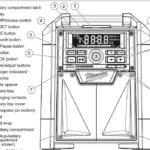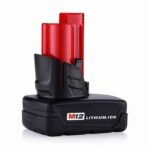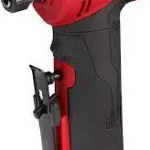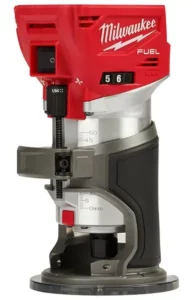
milwaukee Fuel Laminate Trimmer User Manual
GENERAL POWER TOOL SAFETY WARNINGS
WARNING
Read all safety warnings, instruc-tions, illustrations and specifica-tions provided with this power tool. Failure to follow all instructions listed below may result in electric shock, fire and/or serious injury. Save all warnings and instiructions for future reference. The term “power tool” in the warnings refers to your mains-operated (corded) power tool or battery-oper-ated (cordless) power tool. WORK AREA SAFETY •Keep work area clean and well lit. Cluttered or dark areas invite accidents. •Do not operate power tools in explosive atmo-spheres, such as in the presence of flammable liquids, gases or dust. Power tools create sparks which may ignite the dust or fumes. •Keep children and bystanders away while operat-ing a power tool. Distractions can cause you to lose control.
ELECTRICAL SAFETY
Power tool plugs must match the outlet. Never modify the plug in any way. Do not use any adapter plugs with earthed (grounded) power tools. Unmodified plugs and matching outlets will reduce risk of electric shock.
- Avoid body contact with earthed or grounded surfaces, such as pipes, radiators, ranges and refrigerators. There is an increased risk of electric shock if your body is earthed or grounded.
- Do not expose power tools to rain or wet condi-tions. Water entering a power tool will increase the risk of electric shock.
- Do not abuse the cord. Never use the cord for carrying, pulling or unplugging the power tool. Keep cord away from heat, oil, sharp edges or moving parts. Damaged or entangled cords increase the risk of electric shock.
- When operating a power tool outdoors, use an extension cord suitable for outdoor use. Use of a cord suitable for outdoor use reduces the risk of electric shock.
- If operating a power tool in a damp location is unavoidable, use a residual current device (RCD) protected supply. Use of a RCD reduces the risk of electric shock.
PERSONAL SAFETY
- Stay alert, watch what you are doing and use common sense when operating a power tool. Do not use a power tool while you are tired or under the influence of drugs, alcohol or medication. A moment of inattention while operating power tools may result in serious personal injury.
- Use personal protective equipment. Always wear eye protection. Protective equipment such as a dust mask, non-skid safety shoes, hard hat or hearing protection used for appropriate conditions will reduce personal injuries.
- Prevent unintentional starting. Ensure the switch is in the off-position before connecting to power source and/or battery pack, picking up or carrying the tool. Carrying power tools with your finger on the switch or energising power tools that have the switch on invites accidents.
- Remove any adjusting key or wrench before turning the power tool on. A wrench or a key left attached to a rotating part of the power tool may result in personal injury.
- Do not overreach. Keep proper footing and balance at all times. This enables better control of the power tool in unexpected situations.
- Dress properly. Do not wear loose clothing or jewelry. Keep your hair and clothing away from moving parts. Loose clothes, jewelry or long hair can be caught in moving parts.
- If devices are provided for the connection of dust extraction and collection facilities, ensure these are connected and properly used. Use of dust collection can reduce dust-related hazards.
- Do not let familiarity gained from frequent use of tools allow you to become complacent and ignore tool safety principles. A careless action can cause severe injury within a fraction of a second.
POWER TOOL USE AND CARE
- Do not force the power tool. Use the correct power tool for your application. The correct power tool will do the job better and safer at the rate for which it was designed.
- Do not use the power tool if the switch does not Any power tool that cannot be controlled with the switch is dangerous and must be repaired.
- Disconnect the plug from the power source and/ or remove the battery pack, if detachable, from the power tool before making any adjustments, changing accessories, or storing power tools. Such preventive safety measures reduce the risk of starting the power tool accidentally.
- Store idle power tools out of the reach of children and do not allow persons unfamiliar with the power tool or these instructions to operate the power tool. Power tools are dangerous in the hands of untrained users.
- Maintain power tools and accessories. Check for misalignment or binding of moving parts, breakage of parts and any other condition that may tools effect operation . If damaged have the power tool repaired before use. Many accidents are caused by poorly maintained power tools.
- Keep cutting tools sharp and clean. Properly maintained cutting tools with sharp cutting edges are less likely to bind and are easier to control.
- Use the power tool, accessories and tool bits etc. in accordance with these instructions, taking into account the working conditions and the work to be performed. Use of the power tool result in a hazardous situation.
- Keep handles and grasping surfaces dry, clean and free from oil and grease. Slippery handles and rasping surfaces do not allow for safe handling and control of the tool in unexpected situations.
BATTERY TOOL USE AND CARE
- Recharge only with the charger specified by the manufacturer. A charger that is suitable for one type of battercake may create a risk of fire when used with another battery pack.
- Use power tools only with specifically designated battery packs. Use of any other battery packs may create a risk of injury and fire.
- When battery pack is not in use, keep it away from other metal objects, like paper clips, coins, keys, nails, screws or other small metal objects, that can make a connection from one terminal to another. Shorting the battery terminals together may cause burns or a fire.
- Under abusive conditions, liquid may be ejected from the battery; avoid contact. If contact accident-tally occurs, flush with water. If liquid contacts eyes, additionally seek medical help. Liquid ejected from the battery may cause irritation or burns.
- Do not use a battery pack or tool that is dam-aged or mode r led. Damaged or modified batteries may exhibit unpredictable behavior resulting in fire, explosion or risk of injury.
- Do not expose a battery pack or tool to fire or excessive temperature. Exposure to fire or temperature above 130°C (265°F) may muse explosion.
- Follow all charging instructions and do not charge the battery pack or tool outside the temperature range specified in the instructions. Charging im-properly or at temperatures outside the specified range may damage the battery and increase the risk of fire.
SERVICE
- Have your power tool serviced by a qualified repair person using only identical replacement parts. This will ensure that the safety of the power tool is maintained.
- Never service damaged battery packs. Service of battery packs should only be performed by the manufacturer or authorised service providers.
SPECIFIC SAFETY RULES FOR LAMINATE TRIMMER
- Use clamps or another practical way to secure and support the workpiece to a stable platform. Holding the work by your hand or against the body leaves it unstable and may lead to loss of control.
- Always hold the tool firmly in your hand(s) dur-ing the start-up. The reaction torque of the motor, as it accelerates to full speed, can cause the tool to twist.
- Maintain a firm grip on the power tool and po-sition your body and arm to allow you to resist kickback forces. The operator can control kick-back forces, if proper precautions are taken.
- Some woods contain preservatives that can be toxic. Take extra care to prevent inhalation and skin contact when working with these materials. Request, and follow, any safety information avail-able from your material supplier.
- Never hold the workpiece in one hand and the tool in the other hand when using the tool. Never place hands near or below cutting surface. Clamping the material and guiding the tool with both hands is safer.
- Never use dull or damaged bits. Sharp bits must be handled with care. Damaged bits can break during use. Dull bits require more force to push the tool, which could cause the bit to break. Damaged bits can throw carbide pieces and bum the workpiece.
- After changing the bit or making any adjust-ments, make sure the collet nut and any other adjustment devices are securely tightened. Loose adjustment devices can unexpectedly shift, causing loss of control. Loose rotating components will be violently thrown. Watch for vibration or wob-bling that could indicate an improperly installed bit.
- Never start the tool when the bit is in contact with the material. The bit cutting edge may grab the material causing loss of control of the tool.
- Never lay the tool down until the bit has come to a complete stop. The spinning bit can grab the surface and pull the tool out of your control.
- Never touch the bit during or immediately after use. After use the bit, collet, and collet nut may be hot enough to bum bare skin.
- Never clamp the workpiece to a hard surface, such as concrete or stone. Contact with the bit could cause the tool to jump and loss of control.
- Only operate the trimmer when held. Do not clamp or secure the trimmer to a surface and hold the workpiece by hand.
- Never use bits larger than the smallest of the openings in the base, sub-base, or dust collection port.
- Do not loosen or remove the plunge base caps. Internal springs are under pressure. If loosened or removed, the plunge base caps and internal springs will become projectiles, which could cause injury.
 Warning
Warning
To reduce the risk of injury, when working in dusty situations, wear appropriate respiratory protection or use an OSHA compliant dust extraction solution. - Always use common sense and be cautious when using tools. It is not possible to anticipate every situation that could result in a dangerous outcome. Do not use this tool if you do not understand these operating instructions or you feel the work is beyond your capability; contact MILWAUKEE® Tool or a trained professional for additional information or training.
- Maintain labels and nameplates. These carry important information. If unreadable or missing, contact a MILWAUKEE® service facility for a replacement.
 Warning
Warning
Some dust created by power sanding, sawing, grinding, drilling, and other construction activities contains chemicals known to cause cancer, birth defects or other reproductive harm. Some examples of these chemicals are: - Lead from lead-based paint
- crystalline silica from bricks and cement and other masonry products, and arsenic and chromium from chemically-treated lumber. Your risk from these exposures varies, depending on how often you do this type of work. To reduce your exposure to these chemicals: work in a well ventilated area, and work with approved safety equipment, such as those dust masks that are specially designed to filter out microscope is particles.
ADDITIONAL BATTERY SAFETY RULES
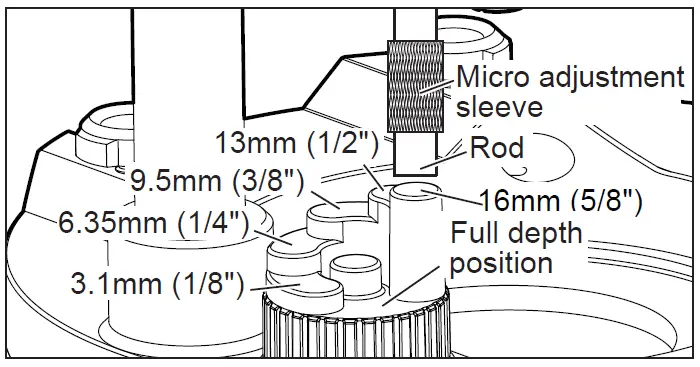 WARNING
WARNING
To reduce the risk of fire, personal injury , and product damage due to a short circuit, never immerse your tool, battery pack or charger in fluid or allow a fluid to flow inside them. Corrosive or conductive fluids, such as seawater, certain industrial chemicals, and bleach or bleach-containing products, etc., can cause a short circuit.
SPECIFICATIONS
Cat. No. M18 FTR
Volts 18V DC
Battery Type M18™
Charger Type M18™
No Load RPM 10,000 – 31,000
Maximum Bit Size 38mm (1-1/2″)
Collet Size 6.35mm (1/4″) & 6
mm Recommended Ambient
Operating Temperature -17°C to 51°C
Plunge Base Cat. No. 48105601
Offset Base Cat. No. 48105602
FUNCTIONAL DESCRIPTION


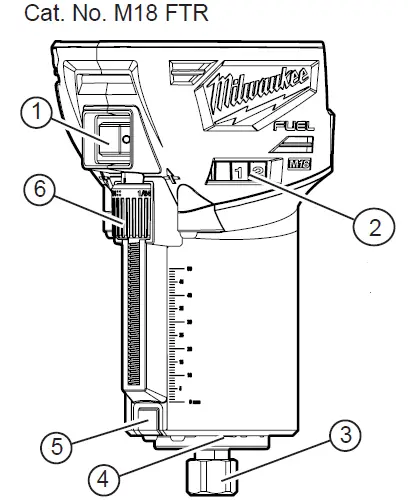

1. ON/OFF switch
2. Speed control dial
3. Collet / collet nut
4. LED (not shown)
5. Spindle lock
6. Micro adjustment dial
7. Quick release lever
8. Macro adjustment button
9. Gripping surface
10. Depth turret
11. Micro adjustment sleeve
12. Handles
13. Depth gauge knob
14. Plunge release lever
15. Depth gauge indicator
16. Depth gauge
17. Shaft / housing hole
SYMBOLOGY
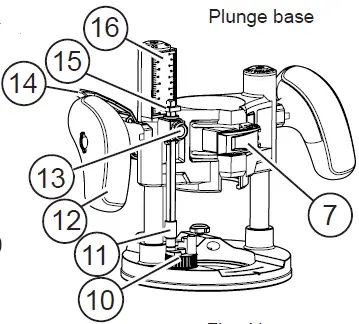 Volts
Volts
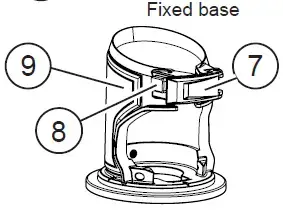 Direct Current
Direct Current
 No Load Revolutions per Minute (RPM)
No Load Revolutions per Minute (RPM)
 Read Operator’s Manual
Read Operator’s Manual
 Wear eye protection.
Wear eye protection.
 Wear hearing protection.
Wear hearing protection.
 Wear dust mask.
Wear dust mask.
 Do not dispose of electric tools together with household waste material. Electric tools and electronic equipment that have reached the end of their life must be collected separately and returned to an environmentally compatible recycling facility.
Do not dispose of electric tools together with household waste material. Electric tools and electronic equipment that have reached the end of their life must be collected separately and returned to an environmentally compatible recycling facility.
 Regulatory Compliance Mark (RCM). This product meets applicable regulatory requirements
Regulatory Compliance Mark (RCM). This product meets applicable regulatory requirements
ASSEMBLY
 WARNING
WARNING
Recharge only with the charger specified for the battery. For spe-cific charging instructions, read the operator’s manual supplied with your charger and battery. Removing/Inserting the Battery To remove the battery, push in the release buttons and pull the battery pack away from the tool.
 WARNING
WARNING
Always remove battery pack before changing or removing accessories. To insert the battery, slide the pack into the body of the tool. Make sure it latches securely into place.
 WARNING
WARNING
Only use accessories specifically recommended for this tool. Others may be hazardous. Always remove battery from tool before changing or removing accessories. Only use accessories specifically recommended for this tool. Others may be hazardous. Installing Collets The collet must be attached to the collet nut before installing the collet assembly to the tool. Be sure that the collet size matches the size of the bit shank, otherwise the collet may break. 1. To assemble, place collet on an even surface, and place the nut over the collet. 2. Press down on the nut to snap the nut and collet together. 3. To disassemble, use a rod to push the collet out of the nut.
Installing/Removing Bits
 WARNING
WARNING
Always remove battery from the tool before attaching or removing accessories or making adjustments. Use only specifically recommended accessories. Others may be hazardous. Never use bits larger than the smallest of the openings in the base, sub-base, or dust shroud. The use of larger bits can result in loss of control and possible serious personal injury. Do not tighten the collet nut without inserting the bit. The collet may break. Never touch the bit during or immediately after use. After use the bit, collet, and collet nut may be hot enough to burn bare skin.
- Turn the On/Off switch to OFF (O) and remove the battery pack.
- Place the trimmer upside down on a workbench.
- Press and hold the spindle lock and use the 17 mm (11/16″) wrench to loosen the collet nut counterclockwise (or use the 11mm (7/16″) spindle lock wrench to hold the spindle securely).
- Insert the bit shank into the collet as far as it will go.
- Back the bit shank out slightly to avoid bottoming out.
- Be sure there is a minimum of 1.6 mm (1/16″) between the bottom of the collet assembly and the radius to the cutting portion of the bit.
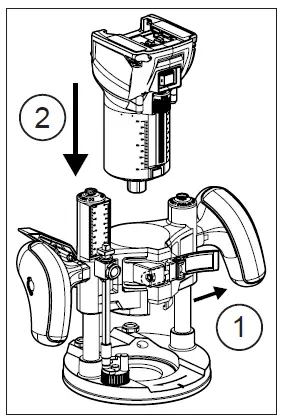
- Be sure that the collet is not clamped to a fluted section on the bit shank. The collet should be clamped to a solid part on the bit shank to ensure a tight grip.
- Hand-tighten the collet nut.
- Press and hold the spindle lock and use the 17 mm (11/16″) wrench to securely tighten the collet nut clockwise (or use the 11 mm (7/16″) spindle lock wrench to hold the spindle securely).
 WARNING
WARNING
If the collet nut is not tightened securely, the bit may come out during use, causing serious persohal injury. Installing/Removing Bases
 WARNING
WARNING
To reduce the risk of injury, DO NOT use the trimmer if the quick release lever does not hold the motor securely in the base. If the quick release lever becomes loose, secure the screw with a 3 mm hex wrench to make a snug fit. Pressing the macro adjustment button will cause the motor housing to drop down, which may cause personal injury or damage to the tool or workpiece. Make sure your hand is firmly on the motor when pressing the button.
Fixed Base
- Open the quick release lever. (1)
- Press the macro adjustment button on the fixed base. (2)
- Insert the tool into the base. (3)
- Release the button.
- Close the quick release lever.
- To remove the base, reverse the procedure.

Accessory Plunge Base
- Open the quick release lever. (1)
- Insert the tool into the base. (2)
- Close the quick release lever.
- To remove the base, reverse the procedure.

Accessory Offset Base
To install the offset base, the collet assembly must be removed from the trimmer motor and installed onto the offset base. The transfer bit must be installed onto the trimmer motor.
- Press and hold the Transfer spindle lock and use the bit 17 mm (11/16″) wrench to loosen the collet nut counterclockwise (or use the 11 mm (7/16″) spindle lock wrench to hold the spindle securely).
- Remove the collet nut and install the transfer bit. ■17 – n’ spindle lock and use rt’
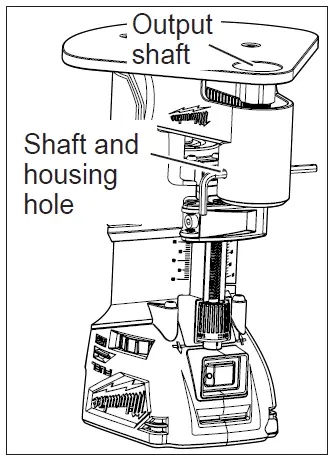
- Press and hold the the 17mm (11/16″) wrench to securely tighten the collet nut clockwise (or use the 17mm (11/16″) spindle lock wrench to hold the spindle securely
- Open the quick release lever. (1)
- Insert the tool into the (2)

- Visually confirm that the transfer bit is seated inside the pulley connection in the offset
- If the transfer bit does not align, remove the motor from the offset base, rotate the transfer bit slightly, and reinstall the
- Close the quick release
- Thread the collet nut assembly into the offset
- Insert the trimmer bit into the collet until it bottoms out.
- To set the depth of cut, insert the 3 mm hex wrench into the micro adjustment set Rotate clockwise (-) or counterclockwise (+) to reach the desired depth of cut.
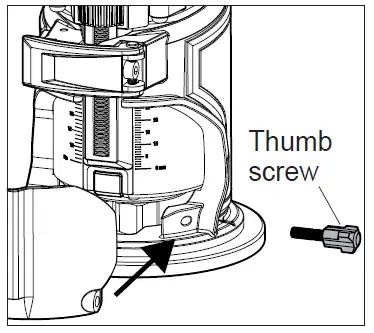
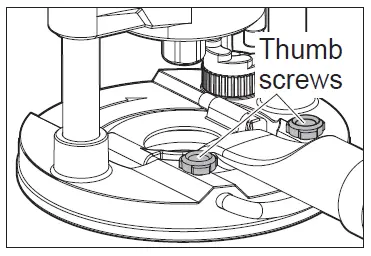
- Rotate the collet nut to align the output shaft hole with the housing hole. Insert the 3 mm hex wrench through both the output shaft and housing

- Use the 17mm (11/16″) wrench to securely tighten the collet nut clockwise.
- To remove the base, reverse the procedure.
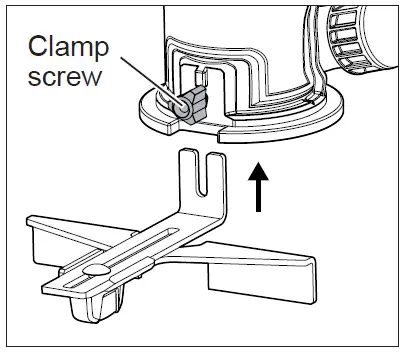
 WARNING During use, always keep vacuum hose clear of the path of the bit.
WARNING During use, always keep vacuum hose clear of the path of the bit.
Fixed Base
- Attach the dust shroud to the fixed base. and tighten thumb screw.
- Connect a vacuum hose to the port.
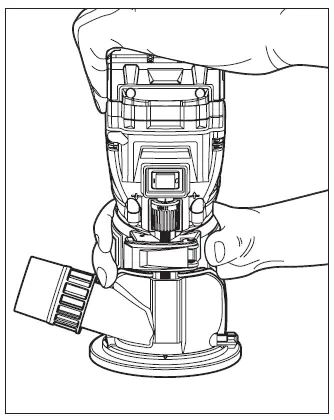
WARNING
To reduce the risk of injury, do not use the dust shroud when plunge cutting if the bit is larger than the port opening 35 mm (1-3/8″). If a rotating trimmer bit contacts the dust shroud, the adapter will break and flying debris may cause injury.
Accessory Plunge Base
Installing a Straight Edge Guide
- Attach the dust shroud to the plunge base, and slide the U-rod into the base holes.
- Tighten the thumb screws.
- Connect a vacuum hose to the port.
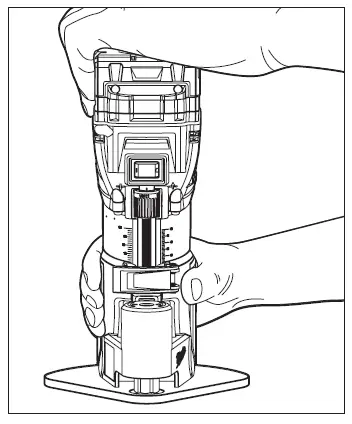
Installing a Straight Edge Guide
The straight edge guide is for use with the fixed base.
1.Assemble the Edge guide . straight edge guide, screw as shown.
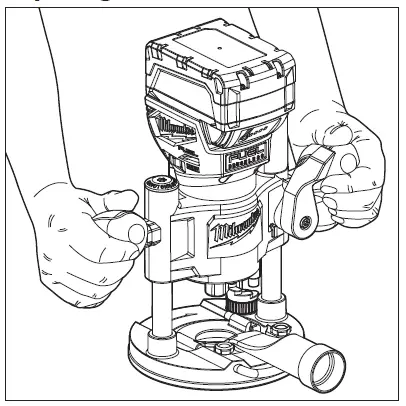
2. Attach the straight edge guide to the Clamp fixed base and tighten the clamp screw securely
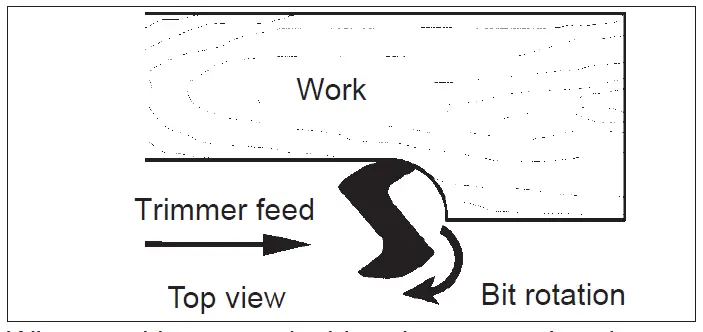
Template Guides
Use only a maximum 30 mm (1-3/16″) template guide with this tool. A 146 mm (5-3/4″) template sub-base plate is needed to install a template guide. Always use a centering cone for best results with a 30mm (1-3/16″) center hole. To install a template guide, insert the guide into the center hole of the subbase and secure according to the template guide instructions.
OPERATION
WARNING To reduce the risk wear proper eye protection marked of injury, always to comply with ANSI Z87.1. When working in dusty situations, wear appropriate respiratory protection or use an OSHA compliant dust extraction solution. Remove the battery before changing accessories or making adjustments.
Never make adjustments while the trimmer is running.
DO NOT use the trimmer if the quick release lever does not hold the motor securely in the base. NEVER use the plunge base in a trimmer table.
Selecting the Speed
The (RPM) of tool can be changed by turning the speed control dial. Variable speed dial settings range from numbers six (6) through one (1). Higher numbers correspond to higher speeds and lower number correspond to lower speeds. Use higher speeds for smaller bits and cutters, softwoods, plastics and laminates. Use lower speeds for larger diameter bits and cutters.
Feedback Control
The electronic speed control system allows the tool to maintain constant speed between no-load and load conditions.
Electronic Overload Protection
These tools are equipped with an electronic overload remove the bit from the workpiece and push the OFF (O) position to reset the tool. Allow the tool to cool before restarting your work.
WARNING Pressing the macro adjustment button will cause the motor housing to drop down, which may cause personal injury or damage to the tool or workpiece. Makeing the button.
Adjusting the Cutting Depth
Fixed Base
Changes to cutter depth can be read on the depth scale on the motor housing. Each mark on the scale indicates a 1.6mm (1/16″) change in depth setting. Use the bottom edge of the removable base as reference when setting depth of cut. To make deeper cuts, make successive passes as required, lowering the bit 3.1 mm (1/8″) for each pass. OFF (O) and remove the battery pack.
- Turn the On/Off switch to OFF (0) and remove the battery pack.
- Open the quick release lever. .
- Press the macro adjustment button and slide the motor close to the desired depth.
- Use the micro adjustment dial to fine-adjust to the desired depth of cut.
- Close the quick release lever. Accessory Plunge Base The plunge base depth of cut can be set two ways; for single pass cuts (shallow cuts less than 3.1mm (1/8″)), or for multiple pass cuts.
The plunge base depth of cut can be set two ways; for single pass cuts (shallow cuts less than 3.1mm (1/8″)), or for multiple pass cuts.

Single Pass Cuts
A shallow cut, such as a mortis cut, can be cut in a single pass.
- Turn the On/Off switch to OFF (0) and remove the battery pack.
- Install the bit and insert the tool into the base.
- Rotate the depth turret until the highest setting 16mm (5/8″) is directly below the depth gauge rod.
- Loosen the depth gauge knob.
- Press the plunge release lever and lower the trimmer motor until the bit touches the workpiece.
- Release the plunge release lever. 7. Set the depth of cut: a. Raise the depth gauge rod and slide the piece to be inlaid (such as a hinge) between the top turret and the depth gauge rod. lighten the depth gauge knob. Remove the reference piece from the turret.
- Set the depth of cut:
(a) Raise the depth gauge rod and slide the piece to be inlaid (such as a hinge) between the top turret and the depth gauge rod. Tighten the depth gauge knob. Remove the reference piece from the turret.
(b) Slide the depth gauge indicator to zero (0) and then raise the depth gauge rod to the desired depth of cut. Tighten the depth gauge knob.
NOTE: do not exceed 3.1mm (1/8″) cut in a single pass. - Make the cut as described in Making the Cut
Multiple Pass Cuts
For cuts more than 3.1mm (1/8″) deep, multiple passes are necessary.
- Turn the On/Off switch to OFF (0) and remove t battery pack.
- Install the bit and insert the tool into the base.
- Rotate the depth turret until the lowest setting (full depth position) is directly below the depth gauge rod.
- Loosen the depth gauge knob.
- Press the plunge release lever and lower the trimmer motor until the bit touches the swisplagg.
- Slide the depth gauge indicator to zero (0).
- Raise the depth gauge rod to the desired depth of cut.
- Tighten the depth gauge knob.
- Use the micro adjustment sleeve for fine adjustments (loosen for a shallower cut, tighten for a deeper cut).
- Press the plunge release lever and raise the trimmer motor.
- Rotate the turret to the highest possible step to prepare for the first cut.
- Make the cut as described in Makixua the Cut -Accessory Plunge Base. Accessory Offset Base The depth of cut of the offset bit is set when the bit s installed.
Accessory Plunge Base.
Accessory Offset Base
warning The depth of cut of the offset bit is set when the bit is installed.
Holding the Tool Keep hands and body away from the bit and all moving parts. Always hold the tool firmly in your hand(s) during the start-up. The reaction torque of the motor, as it accelerates to full speed, can cause the tool to twist. Maintain a firm grip on the power tool and posi-tion your body and arm to allow you to resist kick-back forces. The operator can control kickback forces, if proper precautions are taken. Fixed Base and Accessory Offset Base For best results, hold tool with one hand on the base and a second hand on the top of the battery pack.
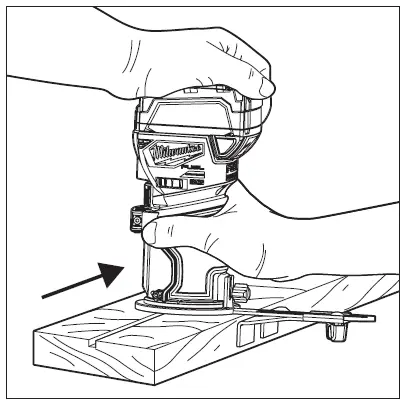

Accessory Plunge Base
To reduce the risk of injury, NEVER use the plunge base in a trimmer table.
Hold tool with both hands on the handles at all times for maximum control.

WARNING
To reduce the risk of injury, always wear eye protection. To reduce the risk of explosion, electric shock and property damage, always check the work area for hidden pipes and wires before trimming. Avoid open area of trimmer base. Serious personal injury will result from contact with a rotating bit. Starting and Stopping the Trimmer Motor
- To start the motor, hold the trimmer so the bit is away from you and not in contact with the workpiece.
- Hold the tool firmly and turn the On/Off switch to ON (I).
- To stop the motor, hold the trimmer so the bit is away from you and turn the On/Off switch to OFF (0). Hold the tool until the bit stops turning.
Making the Cut
Before cutting, check that the collet nut and all adjustments are tight. Verify that the quick release lever is fully closed and secure. Set the speed and depth of cut for material being worked. Keep the cutting pressure constant but do not use excessive force on the trimmer so the motor speed slows excessively. It may be necessary on exceptionally hard woods, problem materials, or
extreme cuts to make more than one pass to get the desired depth of cut. When using the dust collection hose, place the hose
out of the path of the trimmer. Before beginning the cut on the workpiece, make a sample cut on a scrap piece of lumber to check the settings and dimensions. Always be sure the
workpiece is secure before routing. When routing edges, the trimmer should be held firmly down and against the work. Since the cutter rotates clockwise, more efficient cutting will be obtained if the trimmer is moved from left to right as you stand facing the work. The arrows on the base of the tool indicate the direction of bit rotation. When working on the outside of an edge, move trimmer in a counterclockwise direction.
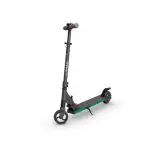
When working on an inside edge, move the trimmer in a clockwise direction. Moving the trimmer in the opposite direction is known as “climb cutting.”
WARNING
To reduce the risk of injury, avoid “climb cutting.” Climb cutting increases the potential for loss of control of the tool and damage to the workpiece. If climb cutting can not be avoided, use extreme caution. Fixed Base with a Straight Edge To obtain a straight cut, use the straight edge guide, or clamp a piece of scrap lumber to use as a guide.
1. To adjust the straight edge guide, loosen the wing nut and ad-just the distance between the bit and the straight edge guide. Tighten the wing nut securely.
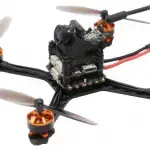
2. To use the straight edge glide, move the too with the straight edge guide flush with the side of the workpiece.
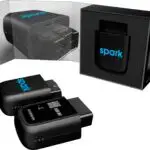
3. To use a piece of scrap lumber as a guide, when the distance between the side of the workpiece and the cutting position is too wide for the straight edge guide, or if the side of the workpiece is not straight. Securely clamp a straight board to the work-piece and use it as a guide against the trimmer base.

Accessory Plunge Base
WARNING Always hold the handles firmly with both hands during operation. Do not use a plunge base trimmer if the motor does not rise automatically when the plunge release lever is pressed.
NEVER use the plunge bake in a trimmer table.
1. Securely clamp the work iece.
2. Set the depth of cut as described in Adjusting the Cutting Depth – Accessory Plunge Base.
3. Press the plunge release lever and raise the bit above the workpiece.
4. Hold the trimmer so the bit is away from you and not in contact with the workpiece. Turn on the tool.
5. Press the plunge release lever and slowly lower the bit into the workpiece until the depth stop rod contacts the turret. Release the plunge release lever.
6. Begin moving the trimmer, keeping the sub base flat on the workpiece.
7. When finished, press the plunge release lever and raise the bit out of the workpiece.
8. To stop the motor, hold the trimmer so the bit is away from you and turn the On/Off switch to OFF (0).
9. For multiple pass cuts, rotate the turret to the next step and repeat. Make multiple passes, rotat-ing the turret to a lower step each time.
MAINTENANCE
WARNING To reduce the risk of injury, always unplug the charger and remove the battery pack from the charger or tool before performing any maintenance. Never disassemble the tool, battery pack or charger. Contact a MILWAUKEE’ service facility for ALL repairs. Maintaining Tool Keep your tool, battery pack and charger in good repair by adopting a regular maintenance program. Inspect your tool for issues such as undue noise, misalignment or binding of moving parts, breakage of parts, or any other condition that may affect the tool operation. Return the tool, battery pack, and charger to a MILWAUKEE° service facility for repair. After six months to one year, depending on use, return the tool, battery pack and charger to a MILWAUKEE° service facility for inspection. If the tool does not start or operate at full power with a fully charged battery pack, clean the contacts on the battery pack. If the tool still does not work properly, return the tool, charger and battery pack, to a MILWAUKEE° service facility for repairs.
WARNING
To reduce the risk of personal in-jury and damage, never immerse your tool, battery pack or charger in liquid or allow a liquid to flow inside them. Cleaning Clean dust and debris from vents. Keep handles clean, dry and free of oil or grease. Use only mild soap and a damp cloth to clean, since certain clean-ing agents and solvents are harmful to plastics and other insulated parts. Some of these include gasoline, turpentine, lacquer thinner, paint thinner, chlorinated cleaning solvents, ammonia and household deter-gents containing ammonia. Never use flammable or combustible solvents around tools.
Repairs
For repairs, return the tool, battery pack and charger to the nearest service centre.
ACCESSORIES
WARNING Use only recommended accesso-ries. Others may be hazardous. For a complete listing of accessories, go online to milwaukeetool.com.aulmilwaukeetool.co.nz or contact a distributor.
WARRANTY – AUSTRALIA and NEW ZEALAND
Please refer to Australian and New Zealand warranty supplied with tool. This warranty applies only to product sold in Australia and New Zealand.
SERVICE – AUSTRALIA and NEW ZEALAND
MILWAUKEE®prides itself in producing a premium quality product that is Nothing But Heavy Duty®. Your satisfaction with our products is very important to us! If you encounter any problems with the operation of this tool, please contact your authorised MILWAUKEE® dealer. For a list of MILWAUKEE® dealers, guarantee or service agents please contact MILWAUKEE® Customer Service or visit our website. (Australia Toll Free Telephone Number 1300 645 928)
(New Zealand Toll Free Telephone Number 0800 645 928) or visit milwaukeetool.com.au/milwaukeetool.co.nz.
Milwaukee Electric Tool Corporation
13135 West Lisbon Road, Brookfield, Wisconsin U.S.A. 53005
Milwaukee Tool (Australia)
21 Kelletts Road, Rowville, VIC 3178 Melbourne, Australia
Milwaukee Tool (New Zealand) 274 Church Street, Penrose, Auckland, 1061, New Zealand
Designed by Milwaukee Electric Tool Corp.
Professionally Made in China for Milwaukee Tool (Australia) / Milwaukee Tool (New Zealand) Printed in China
